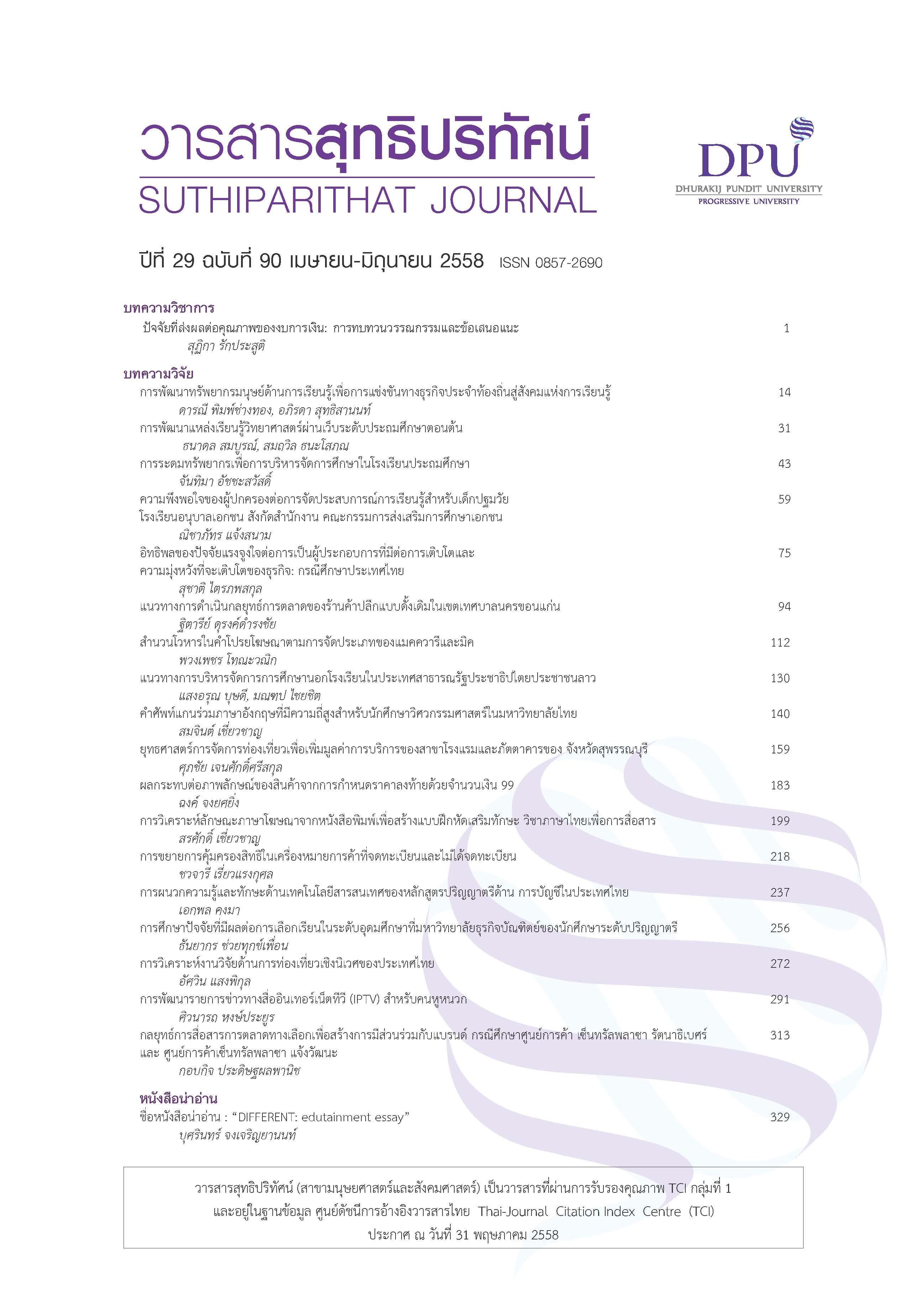สำนวนโวหารในคำโปรยโฆษณาตามการจัดประเภทของแมคควารีและมิค
คำสำคัญ:
สำนวนโวหาร, ภาษาโฆษณา, สำนวนเปรียบเทียบ, ประเภทสำนวนโวหารของแมคควารีและมิคบทคัดย่อ
บทความนี้นำเสนอผลการศึกษาเบื้องต้นของการวิจัยประยุกต์ที่มีวัตถุประสงค์สองประการ คือ ศึกษาการใช้สำนวนโวหารตามการจัดประเภทสำนวนโวหารของแมคควารีกับมิค (1996) และศึกษาปริมาณความถี่ของการใช้สำนวนแต่ละประเภทในโฆษณาสินค้าในสื่อสิ่งพิมพ์ที่เผยแพร่ในประเทศมาเลเซีย คำโปรยโฆษณาทุกข้อความที่ปรากฏในนิตยสารสำหรับผู้หญิงสองฉบับที่มีการใช้สำนวนโวหารได้รับการจัดประเภทและตีความ จากนั้นจึงวิเคราะห์ความถี่ของการใช้แต่ละประเภท สถิติอย่างง่ายที่นำมาใช้ในการการศึกษานี้คือ การแสดงร้อยละและความถี่
ผลการศึกษาแสดงว่าโฆษณาเหล่านี้มีการใช้สำนวนโวหาร 13 ประเภทเพื่อให้ผู้อ่านหรือผู้บริโภคสนใจและเข้าใจคุณลักษณะและคุณสมบัติที่โดดเด่นของผลิตภัณฑ์ได้ เทคนิคสำนวนที่ใช้ในการเขียนคำโปรยส่วนใหญ่จะใช้เทคนิคระดับ Substitution และ Destabilization ประเภทที่ใช้บ่อยมากที่สุดคือคำอุปมาอุปมัย (Metaphor) และสามลำดับถัดมาคือ คำพูดที่เกินความจริง (Hyperbole) คำที่มีสัมผัสอักษร (Alliteration) และคำที่มีความหมายสองนัยหรือการเล่นคำ (Pun) การตั้งคำถาม (Rhetorical Question) รวมถึงคำพ้องเสียง (Assonance) สำนวนที่ใช้น้อยมาก คือ การใช้คำแทน (Metonymy) การใช้คำปฏิทรรศ์ (Paradox) และการใช้คำหรือวลีที่มีโครงสร้างเหมือนต่อเนื่อง (Parison) ซึ่งมีการใช้เพียงประเภทละหนึ่งครั้งเท่านั้น
เอกสารอ้างอิง
CLEO, Malaysia Edition. (November, 2010). Kuala Lumper: Blu Inc Media Sdn Bhd.
CLEO, Malaysia Edition. (December, 2010). Kuala Lumper: Blu Inc Media Sdn Bhd.
CLEO Magazine. (2010). Retrieved November 10, 2010, from www.acpmagazines.com.my.
Lagerwerf, L., & Meijers, A. (2008). Openness in metaphorical and straightforward advertisements Appreciation effects. Journal of Advertising, 37(2), 19-30.
Langrehr, D. (2003). From a semiotic perspective: inference formation and the critical comprehension of television advertising. Reading Online. Retrieved October 17, 2009, from http://www.readingonline.org/articles/langrehr/
Leigh, J. H. (1994). The use of figures of speech in print ad headlines. Journal of Advertising, 23(2), 17-33.
McGuire, W. J. (2000). Standing on the shoulders of ancients: Consumer research, persuasion, and figurative language. The Journal of Consumer Research, 27(1), 109-114.
McQuarrie, E. F., & Mick, D. G. (1996). Figures of rhetoric in advertising language. The Journal of Consumer Research, 22(4), 424-438.
McQuarrie, E. F., & Mick, D. G. (2003).Visual and verbal rhetorical figures under directed processing versus incidental exposure to advertising. The Journal of Consumer Research, 29(4), 579-587.
McQuarrie, E. F., & Mick, D. G. (2009). A laboratory study of the effect of verbal rhetoric versus repetition when consumers are not directed to process advertising. International Journal of Advertising, 28(2), 287-312. Retrieved September 25, 2009, from http://gates.comm.virginia.edu/DGM9T/McQuarrie%20and%20Mick,%202009%20A%20Laboratory%20Study%20of%20Verbal%20Rhetoric%20and%20Message%20Repetition.pdf
Mulken, M., Dijk, R. E., & Hoeken, H. (2005). Puns, relevance and appreciation in advertisements. Journal of Pragmatics, 37, 707–721.
Mzoughi, N., & Abdelhak, S. (2011). The Impact of Visual and Verbal Rhetoric in Advertising on Mental Imagery and Recall. International Journal of Business and Social Science, 2(9), 257.
Nordquist, R. (2009). Figures of Speech in Advertising Slogans. Retrieved September 25, 2009, From http://grammar.about.com/od/rhetoricstyle/a/quizfigslogans.htm.
Palmer, B. C., & Brooks, M. A. (2004). Reading until the cows come home: Figurative l anguage and reading comprehension. Journal of Adolescent and Adult Literacy, 47(5), 370-379.
Philips, B. J. (2000). The impact of verbal anchoring on consumer response to image ads. Journal of Advertising, 29(1), 15-24.
Philips, B. J., & McQuarrie, E.F. (2009). Impact of advertising metaphor on consumer beliefs: Delineating the contribution of comparison versus deviation factors. Journal of Advertising, 38(1), 49-61.
Supasamut, P. (2006). A Classification of Figurative Language Used in Lipstick Advertisements in Women Magazines. (Master’s thesis, Srinakarinwirot University, Bangkok.
Toncar, M., & Munch, J. (2001). Consumer responses to tropes in print advertising. Journal of Advertising, 30(1), 55-65.
Wiehardt, Ginny. (2009). Figure of Speech. Retrieved September 20, 2009. From http://fictionwriting.about.com/od/glossary/g/FigureSpeech.htm.
ดาวน์โหลด
เผยแพร่แล้ว
รูปแบบการอ้างอิง
ฉบับ
ประเภทบทความ
สัญญาอนุญาต
เนื้อหาและข้อมูลในบทความที่ลงตีพิมพ์ในวารสารสุทธิปริทัศน์ ถือเป็นข้อคิดเห็นและความรับผิดชอบของผู้เขียนบทความโดยตรงซึ่งกองบรรณาธิการวารสาร ไม่จำเป็นต้องเห็นด้วย หรือร่วมรับผิดชอบใด ๆ
บทความ ข้อมูล เนื้อหา รูปภาพ ฯลฯ ที่ได้รับการตีพิมพ์ในวารสารสุทธิปริทัศน์ ถือเป็นลิขสิทธิ์ของวารสารสุทธิปริทัศน์หากบุคคลหรือหน่วยงานใดต้องการนำทั้งหมดหรือส่วนหนึ่งส่วนใดไปเผยแพร่ต่อหรือเพื่อกระทำการใด ๆ จะต้องได้รับอนุญาตเป็นลายลักษณ์อักษรจากวารสารสุทธิปริทัศน์ก่อนเท่านั้น







